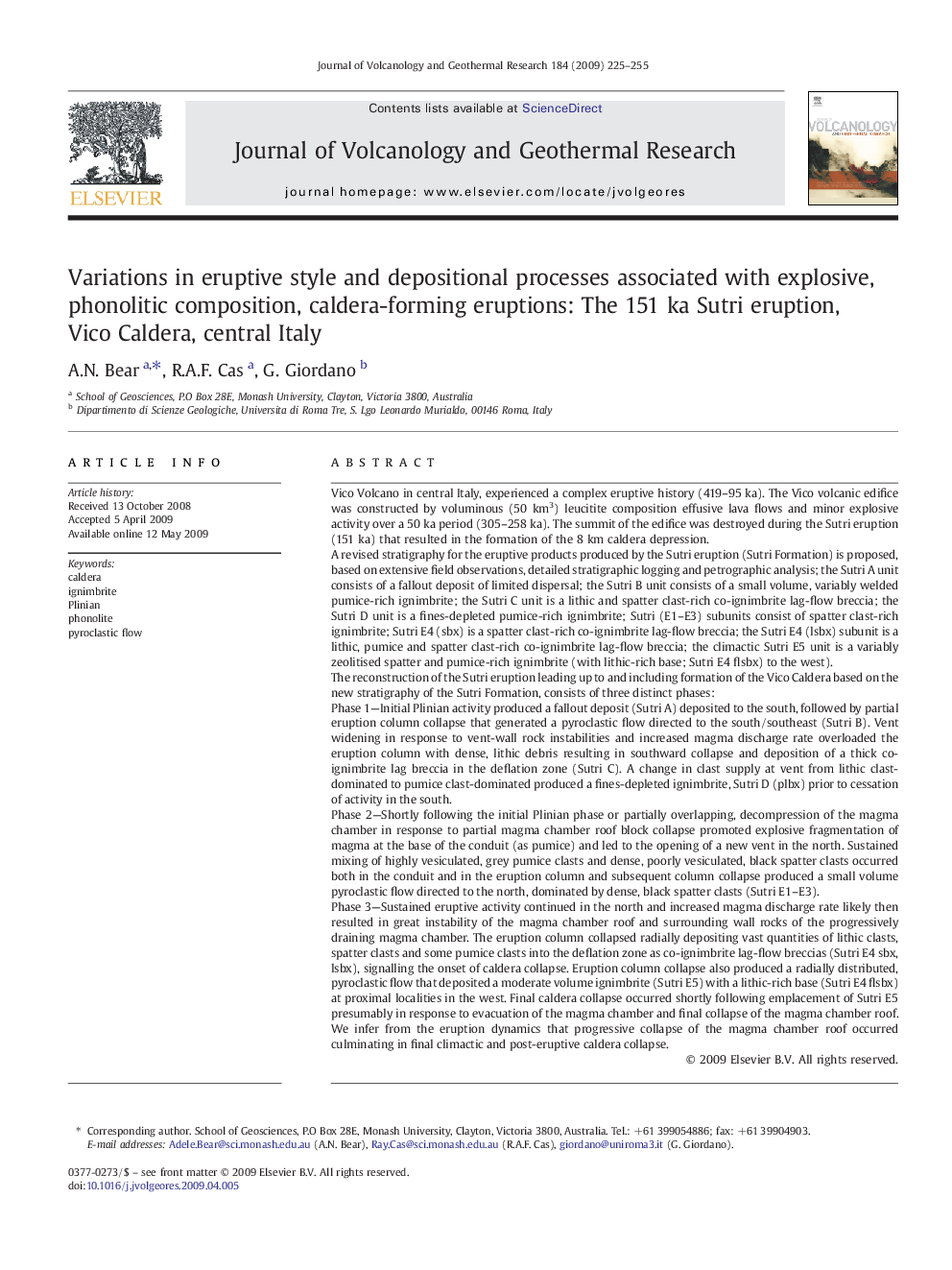| کد مقاله | کد نشریه | سال انتشار | مقاله انگلیسی | نسخه تمام متن |
|---|---|---|---|---|
| 4714245 | 1638434 | 2009 | 31 صفحه PDF | دانلود رایگان |

Vico Volcano in central Italy, experienced a complex eruptive history (419–95 ka). The Vico volcanic edifice was constructed by voluminous (50 km3) leucitite composition effusive lava flows and minor explosive activity over a 50 ka period (305–258 ka). The summit of the edifice was destroyed during the Sutri eruption (151 ka) that resulted in the formation of the 8 km caldera depression.A revised stratigraphy for the eruptive products produced by the Sutri eruption (Sutri Formation) is proposed, based on extensive field observations, detailed stratigraphic logging and petrographic analysis; the Sutri A unit consists of a fallout deposit of limited dispersal; the Sutri B unit consists of a small volume, variably welded pumice-rich ignimbrite; the Sutri C unit is a lithic and spatter clast-rich co-ignimbrite lag-flow breccia; the Sutri D unit is a fines-depleted pumice-rich ignimbrite; Sutri (E1–E3) subunits consist of spatter clast-rich ignimbrite; Sutri E4 (sbx) is a spatter clast-rich co-ignimbrite lag-flow breccia; the Sutri E4 (lsbx) subunit is a lithic, pumice and spatter clast-rich co-ignimbrite lag-flow breccia; the climactic Sutri E5 unit is a variably zeolitised spatter and pumice-rich ignimbrite (with lithic-rich base; Sutri E4 flsbx) to the west).The reconstruction of the Sutri eruption leading up to and including formation of the Vico Caldera based on the new stratigraphy of the Sutri Formation, consists of three distinct phases:Phase 1—Initial Plinian activity produced a fallout deposit (Sutri A) deposited to the south, followed by partial eruption column collapse that generated a pyroclastic flow directed to the south/southeast (Sutri B). Vent widening in response to vent-wall rock instabilities and increased magma discharge rate overloaded the eruption column with dense, lithic debris resulting in southward collapse and deposition of a thick co-ignimbrite lag breccia in the deflation zone (Sutri C). A change in clast supply at vent from lithic clast-dominated to pumice clast-dominated produced a fines-depleted ignimbrite, Sutri D (plbx) prior to cessation of activity in the south.Phase 2—Shortly following the initial Plinian phase or partially overlapping, decompression of the magma chamber in response to partial magma chamber roof block collapse promoted explosive fragmentation of magma at the base of the conduit (as pumice) and led to the opening of a new vent in the north. Sustained mixing of highly vesiculated, grey pumice clasts and dense, poorly vesiculated, black spatter clasts occurred both in the conduit and in the eruption column and subsequent column collapse produced a small volume pyroclastic flow directed to the north, dominated by dense, black spatter clasts (Sutri E1–E3).Phase 3—Sustained eruptive activity continued in the north and increased magma discharge rate likely then resulted in great instability of the magma chamber roof and surrounding wall rocks of the progressively draining magma chamber. The eruption column collapsed radially depositing vast quantities of lithic clasts, spatter clasts and some pumice clasts into the deflation zone as co-ignimbrite lag-flow breccias (Sutri E4 sbx, lsbx), signalling the onset of caldera collapse. Eruption column collapse also produced a radially distributed, pyroclastic flow that deposited a moderate volume ignimbrite (Sutri E5) with a lithic-rich base (Sutri E4 flsbx) at proximal localities in the west. Final caldera collapse occurred shortly following emplacement of Sutri E5 presumably in response to evacuation of the magma chamber and final collapse of the magma chamber roof.We infer from the eruption dynamics that progressive collapse of the magma chamber roof occurred culminating in final climactic and post-eruptive caldera collapse.
Journal: Journal of Volcanology and Geothermal Research - Volume 184, Issues 3–4, 20 July 2009, Pages 225–255